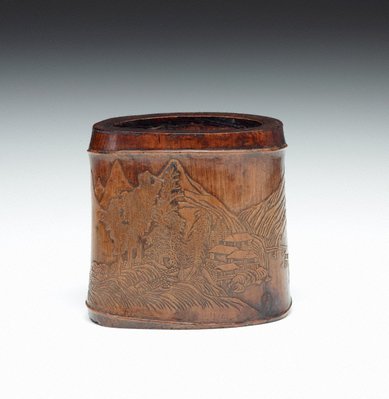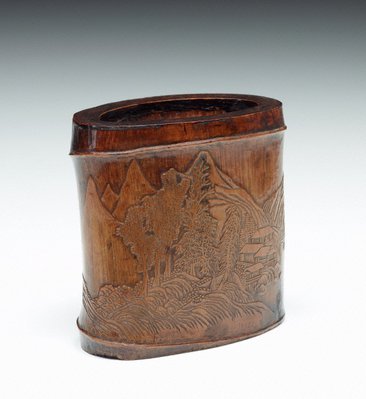

-
Details
- Place where the work was made
-
China
- Date
- 19th century-20th century
- Media category
- Woodwork
- Materials used
- bamboo
- Dimensions
- 11.0 x 10.7 cm
- Credit
- Gift of John Yu, in memory of George Soutter 2012. Donated through the Australian Government Cultural Gifts Program.
- Location
- Not on display
- Accession number
- 143.2012
- Copyright
- Share
-
-
About
The decorations on both sides suggest this piece was made for a scholar. On one side are the landscape and pavilions resembling a painting; on the other side are imitations of Chinese characters copied from bronze mirrors and utensils. The study of bronze inscriptions was an important pursuit of Chinese scholars as part of the archaism in the 18th and 19th centuries.
On the rim: “Da Ji Yang, Yi Hou Wang” (Great good fortune and benefits to the Marquis) were the words often cast on Han dynasty bronzes for their auspicious meanings.
The first two vertical lines on the right: “Guan Lu Suo Ping” have been found on bronze measuring utensils of the Han dynasty. The rest of the inscriptions are copied from a bronze 'yi' utensil, also from the Han dynasty.Asian Art Department, AGNSW, June 2012.
Bamboo Carving:
The earliest mention of a bamboo brush pot in literature appears during the Song dynasty (960-1127). Zhu Yizun of the Ming dynasty (1368-1644) wrote in his 'Bi Tong Ming' ('On Brush Pot'): “Brushes that lie on the desk randomly are like people who don’t have proper deportment. When they are put in a brush pot, like guests finding a home, they become proper.”Starting from the late Ming dynasty, the literati of the day stressed the cultivation of 'ya' (elegant, refined distinguished) style in their life. This style was expressed in their studies, carved bamboo ornaments, including brush pots ('bitong'), arm rests ('bige') and incense tubes ('xiangtong'). These were highly sought after because bamboo was considered as one of the four symbols for 'gentleman' whose integrity should be like the sections on bamboo trunks that go higher and higher.
The art of bamboo carving, probably started as early as the Tang dynasty, and became a unique art form. At its apogee in the early Qing dynasty (1644-1911), bamboo carving eclipsed all other similar forms of art and craft.
-
Places
Where the work was made
China
